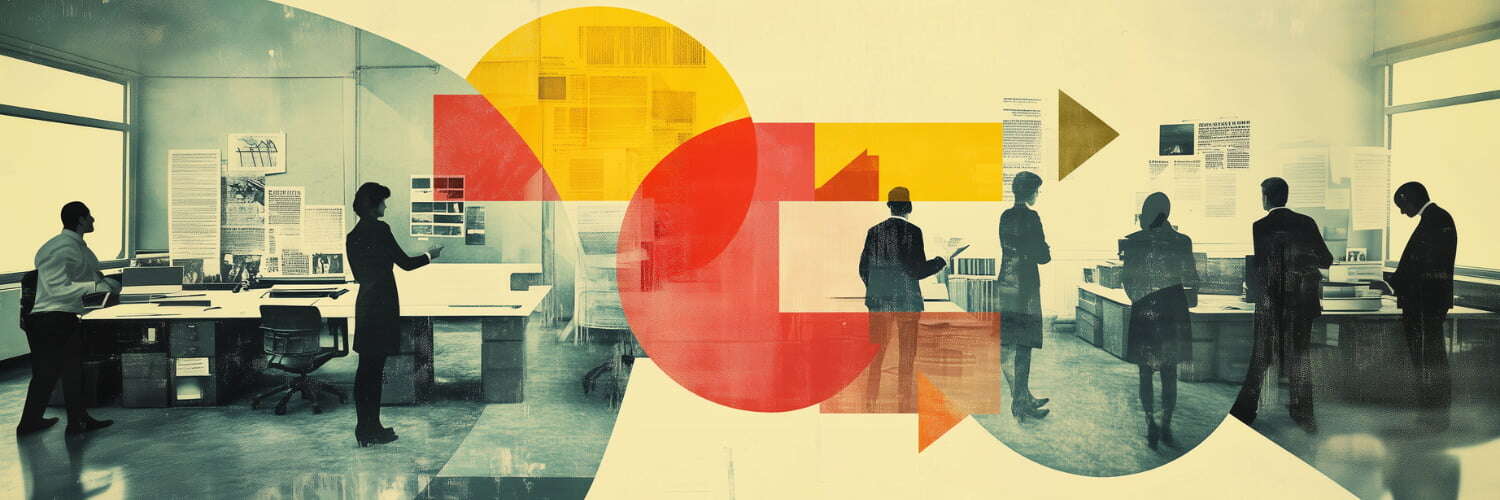We often hear the terms "teamwork" and "collaboration" in the corporate world. But are these terms the same thing, just with different names? Or do they have unique meanings, each adding its distinct flavor to how we work together?
Diving into the "collaboration vs. teamwork" topic isn't about choosing one over the other. Instead, it's about grasping differences, recognizing how they complement each other, and using both to drive your team toward success.
TL;DR:
- Understanding the differences between collaboration and teamwork is key.
- Teamwork focuses on collective effort and shared responsibility.
- Collaboration encourages diverse perspectives and innovative thinking.
- Both share goals, communication, and trust.
- Teamwork is unified, while collaboration involves diverse objectives.
- Effective workplaces often use both teamwork and collaboration.
- Benefits include creativity, morale, decision-making, and productivity.
- Foster open communication, inclusivity, clear goals, and interdependence.
- Leadership shapes teamwork and collaboration culture.
- Technology aids in communication, project management, and brainstorming.
- In the hybrid workplace, teamwork and collaboration are essential.
Collaboration vs. Teamwork: Definitions
While collaboration and teamwork are often tossed around as if they mean the same thing, they're like two sides of the same coin with distinct features. Let's explore the definitions of collaboration and teamwork, revealing their subtle yet significant differences.

What Is Teamwork?
Fundamentally, teamwork is a shared effort toward achieving a specific objective or goal.
The teamwork definition revolves around collective effort and encompasses mutual support. Individuals in a team complement each other's abilities by leveraging their unique strengths and skills to accomplish tasks effectively.
There are two key aspects to keep in mind when analyzing the concept of teamwork:
- Interdependence: This characteristic signifies that team members rely on others' efforts to achieve the objective. Nobody can succeed single-handedly – everyone depends on each other for different project elements.
- Shared responsibility: A hallmark feature of any team is shared responsibility. Each person contributes equally toward task completion, and accountability is collective.
In contrast to independent work, teamwork fosters diversity in ideas and perspectives; it helps mitigate risks while boosting overall productivity.
Effective teamwork goes beyond merely working together. It involves strategically aligning individual skills with project demands—ultimately leading toward optimum business outcomes.
What Is Collaboration?
Collaboration refers to the working relationship among members of an organization, where team members focus on a shared business goal to complete projects swiftly and effectively.
Primarily, collaborating encourages different perspectives to flow freely within a group setting. Individuals encouraged to collaborate do not merely work in conjunction but rather intertwine their expertise in pursuit of better solutions.
In other words, collaboration is like creating a mosaic drawing from various unique pieces. Each team member represents a piece that adds value because of its shape and color. Together, they form a nuanced image symbolizing common objectives.
In essence:
- Collaboration emphasizes thought exchange;
- It is based on diversity, as each viewpoint contributes uniquely;
- It breeds innovation through collective ideation.
Collaboration leads to constructive discussions since all players come together as equals, seeking joint success instead of personal accolades. It thrives on recognizing that we can often achieve more when we pool resources and knowledge together.
Similarities between Collaboration and Teamwork
One common factor when considering collaboration and teamwork is their shared aim: achieving a shared objective or task completion. Both constructs bring different people together to combine their talent, ideas, skills, and expertise for mutual success.
Another similarity between the two concepts is the necessity for communication. Effective communication strategy is paramount regardless of the nature of a group's structure. It ensures all parties remain aligned with the target objective and comprehends each individual's role in reaching it.
Trust forms yet another link between collaboration in teams and teamwork. It encourages honesty and openness among team members while fostering a safe atmosphere where individuals can suggest innovative solutions without fear of reproach or dismissal.
To condense:
- Shared goal: Teamwork and collaboration share objectives that move everyone forward collectively.
- Communication: Effective dialogue is critical to understanding one another's roles and focusing on collective targets.
- Trust: A prerequisite for successful collaborations within teams and teamwork.
Despite these similarities, discernible differences still unfold when examining 'teamwork' versus 'collaboration.' Let's move to these distinguishing characteristics.
What’s the Difference Between Collaboration and Teamwork?
Many people interchangeably use the terms collaboration and teamwork, assuming they mean the same. However, intricacies distinguish one from the other. It's essential to fully comprehend these nuances to truly understand collaboration vs. teamwork dynamics.
The major difference between collaboration and teamwork is their individual goals and processes. Teamwork implies working together as a unified entity towards shared objectives, with each member contributing based on predefined roles. What does this look like on a practical level? Picture a basketball team. Every player understands their position: guard, forward, or center; has specific responsibilities therein, collectively striving for that all-important score.
Contrastingly, collaboration centers around harnessing diverse skill sets of individuals working together but not necessarily being part of the same team or executing similar tasks.
Here are more ways collaboration differs from teamwork:
- Goals and objectives: For teamwork, these often manifest as collective targets driven by unity. Meanwhile, collaborations can witness different parties bringing unique objectives to the table.
- Risk & reward distribution: Everyone assumes equal risk or reward regardless of input level in team scenarios. Collaboratively, however, risks are singular, while rewards tend to be mutual.
- Role flexibility: With rigid guidelines defining roles within teams, collaboration encourages versatile contributions, allowing those involved to step up wherever needed.
Emphasizing these differences is vital when considering how best to approach projects requiring group work and gauging whether collaboration or traditional teamwork would yield superior results. Remember, though, it doesn't always imply an either/or choice – effective workplaces often embrace both when appropriate.

The Upsides of Teamwork and Collaboration
One might wonder why there has been so much emphasis on teamwork and collaboration lately. The answer lies in the numerous benefits they bring to an organizational environment.
Creativity and Innovation
Fostering a culture where collaboration and teamwork thrive opens the door to unparalleled creativity and innovation. When multiple minds, each carrying distinct knowledge bases and perspectives, come together, they invariably stumble upon novel approaches that may have yet to be realized individually.
Employee Morale and Cohesion
Surprisingly enough, collaboration is about more than just work! It inadvertently brings team members closer on a human level as well. As colleagues unite towards shared goals, camaraderie gets boosted, increasing morale and team cohesion.
Better Decision-Making
Teamwork and collaboration tend to streamline decision-making processes in ways that cannot be underestimated. By gathering diversified viewpoints through open communication channels splattered throughout the collaborative framework, informed decisions can be made quicker with minimal chances of overlooking crucial details.
Enhanced Productivity
Lastly, but certainly not least significantly, cooperative endeavors yield higher productivity levels. How? By fostering mutual learning environments where tasks are accomplished through shared efforts rather than individual exertions.
To actualize these benefits, it is vital to actively cultivate practices enhancing both teamwork and collaboration - a topic we will explore in the following section.
How to Improve Teamwork and Collaboration in Your Organization?
Strengthening the abilities of a team to collaborate effectively is paramount. The essence lies in fostering an environment that encourages collaboration and teamwork, promotes sharing ideas, and removes inhibitions. Here's how we can achieve this:
Open Communication Lines
Clear communication strategy helps eliminate misunderstandings and removes barriers, ensuring everyone is on the same page. Foster an environment where individuals feel comfortable voicing their opinions or concerns without hesitation.
Inclusivity
In any setting, it’s crucial to value diversity and inclusivity. Every teammate has unique skills and perspectives; inclusion strengthens these differences. Creating an inclusive atmosphere lays a robust foundation for collaboration and teamwork.
Clear Goals
A clear objective unites people towards common success. When each individual understands their role in achieving the goals of the project at hand, the potential for collaboration skyrockets.
Interdependence
Promoting interdependent work between teams creates more opportunities for teamwork versus reliance on individual efforts alone. It aligns unique strengths with collaborative teamwork, enhancing overall performance substantially.
Team Coordination
Efficient team coordination is vital to enhance teamwork and collaboration within an organization because it ensures that tasks are completed seamlessly, and objectives are achieved with maximum effectiveness. When team members coordinate their efforts efficiently, they can leverage each other's strengths, minimize work duplication, and promptly address potential conflicts or roadblocks.
The Pivotal Impact of Leadership on Teamwork and Collaboration
Leadership plays a pivotal role in shaping the success of teamwork and collaboration within an organization. Effective leaders provide direction, establish clear goals, and create an environment where team members feel valued and motivated. They set the tone for open communication, trust, and mutual respect, which are essential to successful collaboration. Additionally, strong leadership can resolve conflicts, offer guidance during challenges, and ensure that resources and responsibilities are allocated efficiently. When leaders prioritize and model collaborative behaviors, they inspire their teams to work cohesively, resulting in improved problem-solving, innovation, and overall productivity. In essence, leadership is the driving force that enables individuals to come together as a unified, high-performing team, ultimately leading to achieving organizational objectives.

Teamwork and Collaboration in the Hybrid Workplace
Teamwork and collaboration are at the heart of the hybrid workplace's dynamics. As employees split their time between remote and in-office work, the ability to work cohesively has never been more critical.
In the hybrid work setting, teams must rely on digital tools and platforms for communication and project management. However, effective collaboration goes beyond technology; it demands a shared understanding of roles and responsibilities and clear communication channels to ensure that everyone's voice is heard, regardless of their location.
Nurturing a collaborative culture becomes imperative, emphasizing values like trust, open communication, and mutual support. In the hybrid workplace, teamwork and collaboration enable organizations to harness their diverse workforce's collective skills and insights, driving innovation, problem-solving, and achieving shared objectives.
Technology to Maximize Teamwork and Collaboration in Hybrid Workplaces
With technological advancements shaping the business environment, digital platforms are crucial in nurturing teamwork and collaboration, especially in the hybrid workplace. These tools present a virtual space where team members can connect, share ideas, schedule, and work together on projects regardless of their physical location.
Communication Tools
Firstly, digital tools facilitate seamless communication within teams. Alongside traditional email systems, instant messaging apps provide real-time interaction among team members. For instance, Slack and Microsoft Teams allow employees to send messages instantly without disrupting workflow. Such smooth communication fuels collaboration and teamwork by ensuring everyone stays updated about ongoing tasks.
Project Management Tools
Secondly, these platforms aid in project management within teams. Using software such as Asana and Trello allows project managers to assign tasks effectively while keeping tabs on progress. Team members can see each other's workload, encouraging accountability and mutual respect.
Brainstorming Tools
Digital platforms also can stimulate creative brainstorming sessions—a significant aspect of collaborative teamwork—by offering features like shared whiteboards and mind maps. Applications like Miro enable all participants to visualize ideas simultaneously, thereby fostering innovative thinking as they collaborate.
Document Sharing Tools
Cloud-based document-sharing systems such as Google Drive or Dropbox have revolutionized how teams collaborate. These systems let anyone edit documents remotely while tracking changes—allowing for multifaceted input from all team members.
Work Scheduling Tools
Work scheduling tools maximize teamwork and collaboration in hybrid workplaces by providing a centralized platform for employees to coordinate their hybrid work schedules. Hybrid workplace software like Yarooms enable teams to plan in-person collaboration and hybrid meetings efficiently, ensuring team members can align their schedules for effective collaboration, even remotely.
Collaboration vs. Teamwork: Summing It Up
Understanding the distinctions between collaboration and teamwork is crucial for optimizing their roles in the workplace. While teamwork emphasizes collective effort and shared responsibility toward a specific goal, collaboration thrives on diverse perspectives and exchanging ideas. Both concepts share the core elements of a common goal, effective communication, and trust, making them essential for organizational success.
The benefits of fostering teamwork and collaboration are evident, from enhancing creativity and decision-making to boosting employee morale and productivity. Promoting open communication, inclusivity, clear goal-setting, interdependence, and efficient team coordination is vital to improving these aspects in your organization.
Leadership plays a pivotal role in shaping the culture of teamwork and collaboration, ensuring that team members feel valued and motivated. Technology, especially in the hybrid workplace, also plays a significant role in facilitating communication, project management, brainstorming, and document sharing, ultimately maximizing the potential for effective collaboration.
In the ever-evolving landscape of work, embracing both collaboration and teamwork is not a choice between one or the other but a strategic approach that can lead to a more innovative, productive, and harmonious work environment where individuals come together to achieve shared objectives, whether in the office or the digital realm.












